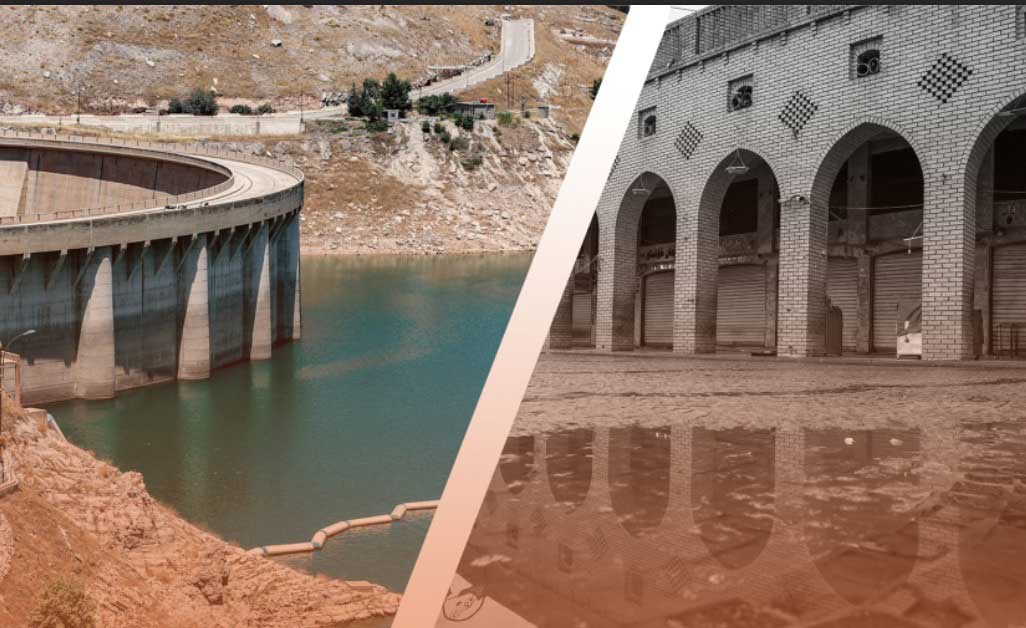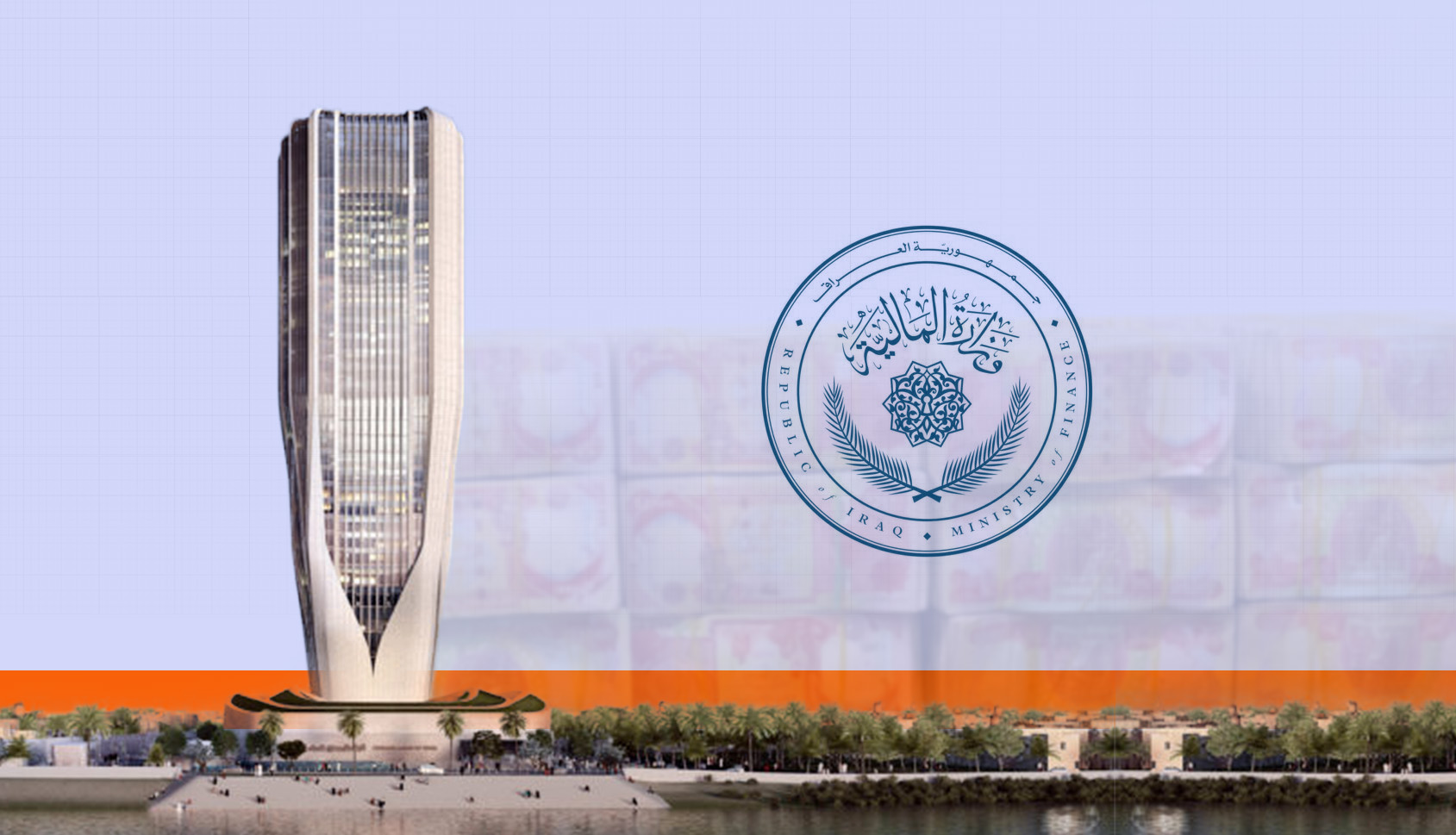Navigating Water Scarcity in the Kurdistan Region: Challenges, Causes, and Crucial Solutions
29-08-2023
Water scarcity is a pressing issue in the Kurdistan Regional Government, threatening the well-being of its population and sustainable development. Insufficient water infrastructure, climate change impacts, political disputes, population growth, and inefficient practices have contributed to this crisis."
The KRI's water crisis is a result of a combination of challenges that demand attention and innovative strategies for resolution. This article explores five crucial factors that play a role in the crisis and possible routes to tackle these challenges.
1.Insufficient water infrastructure
Aging distribution networks: Outdated and inefficient water distribution systems result in significant water losses through leakages and pipeline inefficiencies.
The Ministry of Municipalities and Tourism (MoMT) believes that about 50-60% of the drinking water that is supposed to be delivered is lost because of leaks or unauthorized private connections to the public water system [Ref1].
- Limited wastewater treatment facilities: Insufficient wastewater treatment plants lead to untreated or partially treated wastewater being discharged into water bodies, polluting available water resources.
- According to the Kurdistan Regional Water Authority, only about 10-20% of wastewater in the Kurdistan Region of Iraq (KRI) is treated. This means that the remaining 80% of wastewater is discharged into water bodies untreated or partially treated, which can pollute available water resources [Ref2]. The Tanjaro River, located south of Sulaimaniyah city, is polluted with untreated waste, cleaning products, oils, and harmful metals from factories, waste sites, and refineries. This polluted water then moves into the Darbandikhan Dam reservoir, where hundred thousand of people get their drinking water. After that, the pollutants continue to flow downstream into the lower Sirwan River, and eventually into the Tigris River and the Gulf, affecting many communities along the path Ref 3-4.
- Outdated reservoirs and dams: The Kurdistan Region faces significant water challenges stemming from a combination of factors. Outdated reservoirs and dams, coupled with inadequate water storage infrastructure, lead to water shortages during dry seasons. The Kurdistan Region has over 17 dams and ponds, but many of these dams or ponds are outdated and inefficient. This means that they lose a lot of water through evaporation. In addition, the KRI does not have a well-developed water storage infrastructure. This means that it is difficult to store water during wet seasons for use during dry seasons. With over 17 existing dams and ponds and plans for a dozen more, the region currently holds a total water capacity of 10 billion cubic meters. However, many of these vital water sources suffer from inefficiencies. For instance, the largest dam, Dukan, constructed in 1959, now holds only 2 billion cubic meters of water, a fraction of its 6 billion cubic meter capacity, due to evaporation and leakage. Similarly, Darbandikhan dam, an essential source of water from the Zagros Mountains in Iran, operates at just one-third of its capacity following a seven-meter drop in water levels. These reservoirs are crucial not only for sustaining life and supporting plants and animals but also for supplying drinking water to millions. Regrettably, the situation is exacerbated by a concerning trend: as of 2023, the average water level in KRI dams is 30% lower than it was in 2018, emphasizing the urgency of modernizing and optimizing water management practices in the region Ref 5-6
- Lack of Rain Harvesting Technology: One of the challenges faced is the limited ability to collect and store rainwater when it pours heavily. This issue results in scarcities of water during times when there is little or no rainfall. To address this, the introduction of rainwater harvesting technology could make a meaningful difference for the Kurdistan Region. Rainwater harvesting involves capturing and storing rainwater for later use. There are two main types: ground-level systems where rainwater is collected from surfaces like rooftops and roads, and underground systems where water is stored in tanks beneath the ground. These systems come in different sizes and can play a vital role in ensuring a more secure water supply for the future. While costs for setting up rainwater harvesting systems can vary, depending on the size and materials chosen, the investment could prove invaluable in alleviating water shortages and enhancing water sustainability in the KRI.
2. Climate change impacts:
Reduced precipitation: Changing climate patterns have resulted in decreased rainfall in the region, leading to decreased precipitation from 526.3 mm in 2012 to 347.1 mm in 2022 [7-8].
Increased temperatures: Rising temperatures contribute to higher evaporation rates, reducing the overall water supply and exacerbating water scarcity.
- When the air gets warmer, it can take away more water from the ground and water bodies. This "disappearing" water is called evaporation. Every year, about 15.7 billion cubic meters of water vanish this way, which is like 14.5% of all the water used in the country. In Iraq, super-hot summers, up to 53°C, lead to lost crops, harm to animals like water buffaloes, and fewer different plants and animals. This also makes drinking water not so good and causes lots of fires each year [9]. This situation is causing not enough water, which means there's less water for people and nature. If the temperature goes up by 1 degree Celsius and the rain goes down by 10% by the year 2050, there could be 20% less freshwater. This might mean that almost one-third of the land used for growing plants with water will have no water at all by 2050 in Iraq [5].
- Reduced snowmelt: Snowmelt is an important source of water for the KRI in the spring and summer. However, warmer temperatures are causing snow to melt earlier in the year, which means that there is less water available for later in the season.
- Increased water demand: Warmer temperatures are also leading to increased water demand for human use, such as for drinking, bathing, and irrigation. This is putting a strain on water resources, as there is less water available to meet the needs of both humans and ecosystems.
- In Iraq, temperature escalation occurs at a rate 2 to 7 times faster than the worldwide norm. Consequently, while the Earth's surface temperature has increased by 1.3°F (0.75°C) since the 20th century, Iraq's temperature has surged by 4.1°F (2.3°C). This warming trend is particularly intensified in Northern Iraq, where climate change represents an existing and acknowledged menace to the Kurdish population [10].
3. Political Disputes:
- Transboundary water conflicts: Political disputes and lack of cooperation among neighboring regions or countries sharing water resources can result in inequitable water distribution, exacerbating water scarcity for the Kurdistan Region.
- In the Kurdistan Region, about 70% of the water comes from outside Iraq. However, problems like barriers and limits on water flow from upstream regions have caused a huge 80% decrease in the water that reaches the Kurdistan Region. This has led to severe drops in water levels and less available resources. Turkey and Iran have built dams that act like cannons, indirectly affecting the people downstream, including the Kurds. It's important to know that two rivers, the Little Zab and Sirwan, start in Iran and then flow into the Kurdistan Region. Iran has made dams along these rivers, saying it's for their own needs, but this affects us too. For example, they built the Daryan Dam in 2009 near the Iraqi border along the Sirwan River, and in 2011, they built the Sardasht Dam close to the Iraqi border along the Little Zab River. This situation is causing real challenges for us and our water [11 and, 5].
- Internal territorial disputes: Conflicts over control and governance of water sources within the region can hinder effective water management and infrastructure development, leading to inefficient allocation and utilization of water resources.
- In the central and southern regions of Iraq, the environment is deteriorating due to insufficient water. Since 2017, there have been prolonged periods without rainfall, causing vital water sources to vanish. As an example, Lake Milh, which used to be 112 feet above sea level, has now dropped to 66 feet because of the ongoing drought. The situation is worsened by Turkey and Iran, who are reducing the amount of water they send to Iraq by about 80%. This is causing significant harm to the well-known Iraqi wetlands called marshes, which are even at risk of disappearing entirely [5]. The major rivers in Iraq, the Euphrates and Tigris, are predicted by the Iraqi government to run dry by 2040. Moreover, the World Bank estimates a potential 20% reduction in available drinking water by 2050 [11].
- The construction of dams and diversion projects upstream by Turkey and Iran has led to tensions between the KRG and the central government of Iraq. The upstream countries' actions can affect the downstream flow of water, potentially reducing water availability for both the KRI and Iraq. In recent years, disagreements have arisen between the KRI and Iraq over how to manage and allocate the water from these rivers. The central government in Iraq has expressed concerns that the KRI's construction of dams and water infrastructure could impact the downstream flow, affecting the water supply for southern Iraq [12, 5].
4. Population Growth:
- Rapid urbanization: Urban population growth increases the demand for water, putting additional strain on limited water resources in cities and towns. The population of the Kurdistan Region of Iraq (KRI) has grown significantly in the last 10 years. According to the Kurdistan Regional Statistics Office, the population of the KRI was 4,662,000 in 2013. By 2023, the population had grown to 6,556,752, an increase of 41% [7]. The director of the Water Directorate, Ari Ahmed, highlighted the importance of proper water management, noting that while international standards suggest a daily water requirement of 200 to 250 liters per person, the current supply ranges between 350 to 400 liters. This initiative aims to ensure more responsible water consumption while addressing the decline in underground water levels caused by excessive well extraction in recent years [13].
- Expansion of agricultural activities: Population growth drives the need for increased food production, leading to more extensive agricultural practices that require significant water resources, further exacerbating water scarcity. In Iraq, water usage is primarily directed towards agriculture, with 87.8% of the 43.07 billion cubic meters (BCM) withdrawn for human use in 2017 being utilized for farming, followed by 2.5% for industrial purposes, and 2.7% for municipal water supply. Industrial water consumption has decreased due to conflicts and challenges faced by the country in recent years. Groundwater plays a significant role in agriculture, and over 88,000 wells across Iraq provide water for families, cities, and industries. However, limited information is available regarding consumption rates and the presence of illegal wells. Environmental needs, like the restoration of the Mesopotamian Marshes, require around 10-20 BCM/yr of water, while an additional 8-12 BCM/yr are lost to reservoir evaporation. A water supply deficit is expected in the near future if significant water sector reforms are not undertaken. Deterioration of infrastructure, leakages, outdated systems, and other factors contribute to projected deficits of 10-20 BCM/yr by 2030. Agricultural water use constitutes a substantial portion, with approximately two-thirds of cultivated land relying on irrigation, though low irrigation efficiency and poor agricultural practices limit productivity. The Ministry of Water Resources has developed strategies to decrease freshwater consumption, targeting a 24.5% reduction by 2035, primarily in the agricultural sector through improved efficiency and planning. Hindered by challenges like conflicts and economic difficulties, the implementation of these reforms is a pressing concern for Iraq's water sustainability [14].
5. From Fertility to Drought:
The cradle of civilization, Mesopotamia, which once thrived between the Tigris and Euphrates rivers, now faces an alarming water crisis that threatens its very existence. This region, known for its historical significance and contributions to human development, is grappling with severe desertification and water scarcity. In places like southern Iraq, where the Euphrates River once flowed, villages are now witnessing a drastic decline in water levels, forcing families to abandon their homes and livelihoods. Climate change, desertification, and outdated irrigation practices have led to a dwindling water supply, causing devastating health issues, food shortages, and social conflicts. Upstream dams built in Turkey and Iran have diverted water from Iraq's major rivers, exacerbating the crisis and intensifying tensions in the region. Iraq's vulnerability to climate change serves as a dire warning for other areas facing similar challenges, underscoring the urgent need for adaptive measures to ensure water security and sustainable development [15].
The decline of Mesopotamia's water resources represents a profound shift from its historical significance as a fertile and thriving region. Once celebrated for its lush landscapes and iconic features such as the Hanging Gardens of Babylon, the region is now grappling with a rapidly drying landscape. This crisis is driven by a combination of factors, including climate change, population growth, and mismanagement of water resources. Communities that relied on the Tigris and Euphrates rivers for sustenance and livelihoods are now struggling to survive as water levels dwindle. As rivers and irrigation canals dry up, people are facing displacement, deadly conflicts, and the resurgence of extremist groups. Iraq's struggle with water scarcity serves as a stark illustration of the complex interplay between environmental and political challenges, highlighting the urgent need for international cooperation to address water scarcity, safeguard livelihoods, and ensure a sustainable future for vulnerable regions worldwide [15].
Practical Solutions for a Water-Secure Future in KRI
1. Support the development of water infrastructure projects, such as building dams, water treatment plants, and distribution systems, to ensure the efficient management of water resources.
- Construction of new reservoirs and dams: KRI can increase water storage capacity by building new reservoirs and dams, or by rehabilitating existing ones. This will help to ensure a more reliable water supply during dry seasons and mitigate the effects of water scarcity.
- Upgrading distribution networks: KRI can reduce water losses in its aging water distribution networks by repairing or replacing old pipes, valves, and pumps. This will help to ensure more efficient water delivery to consumers and minimize the amount of water wasted due to leaks.
- Implementing smart water management systems: Advanced technologies such as remote sensing, data analytics, and real-time monitoring can be used to improve the management of water infrastructure. These technologies can collect and analyze data about water use, which can then be used to optimize water distribution, detect leaks, and identify other problems with the infrastructure.
2. Conservation and efficiency: Promote water conservation practices, such as water-efficient usage, and public awareness campaigns to educate individuals about responsible water use.
- Promotion of water-saving practices: Launch water conservation campaigns to educate people and communities about how to save water by using efficient irrigation methods, fixing leaky faucets, and using water-efficient appliances.
- Implementing water pricing mechanisms: Introducing tiered pricing structures or incentives to encourage responsible water use and discourage wasteful practices can incentivize individuals and businesses to adopt more water-efficient behaviors.
3. Rainwater harvesting and storage:
- Installation of rainwater harvesting systems: Encouraging the use of rainwater harvesting systems at both individual and community levels, such as rooftop collection systems and rain gardens, can capture and store rainwater for various non-potable uses like irrigation, washing, and cleaning.
4. Implementing wastewater treatment and reuse systems:
- Establishing wastewater treatment plants and implementing safe water reuse systems for non-potable purposes like irrigation, industrial processes, and urban green spaces. This reduces the demand for freshwater sources and maximizes water resource efficiency.
5. Policy reforms: Critical need for robust water management policies, regulations, and enforcement mechanisms to ensure sustainable use and allocation of water resources. Call for political commitment and cross-sectoral collaboration.
- Development of water management plans and regulations: Create water management plans that focus on sustainability, fair water distribution, and efficient resource use. This includes making rules for water use, discharge, and conservation practices.
- Strengthening institutional capacity: Build strong organizations and governing structures that can effectively manage water resources, monitor compliance with regulations, and enforce water-related policies.
- Enhancing cross-sectoral collaboration: Encourage coordination and cooperation between different sectors, such as government agencies, private sector stakeholders, academia, and civil society, to ensure integrated water management approaches.
Note.
[1] Link
[2] Link
[3] Link
[4] Link
[5] Link
[6] Link
[7] Link
[8] Link
[9] Link
[10] Link
[11] Link
[12] Link
[13] Link
[14] Link
[15] Link






